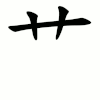艹
| ||||||||
| ||||||||
| ||||||||
Translingual
| Stroke order | |||
|---|---|---|---|
 | |||
| Japanese | 艹 |
|---|---|
| Simplified | 艹 |
| Traditional | 艹 |
Alternative forms
The non-radical form of this character is 艸, with six strokes, and that appears as a radical in a few characters (芔, 茻, and stacked vertically in 芻).
In almost all other characters, however, the radical is a simplified top form. This top form is traditionally written as two separated crosses, 艹, with four strokes (like 十 十, separation may not be visible at small font size). In its modern form, it is a single unit of 艹 (or in some character styles 䒑), with three strokes. Traditional Chinese characters today use either the traditional or modern radical form, while simplified Chinese characters, Japanese shinjitai, and Korean Hanja use the modern radical. Additionally, in a few characters (茍, 蘷, 虁), the radical frequently appears as two separated parts like sideways "T" shapes, 艹, both in traditional and simplified characters. All this can lead to the grass radical being counted as three, four, or six strokes.
The Unicode encodings for the different forms are:
- normal character (艸) U+8278 in the CKJ Unified Ideographs block
- full radical form (⾋) U+2F8B in the Kangxi Radicals block
- modern 3-stroke top radical (艹) U+8279 in the CKJ Unified Ideographs block
- alternate 3-stroke top radical (䒑) U+4491 in the CKJ Unified Ideographs block
- traditional 4-stroke double-cross top radical (艹) U+FA5E in the CJK Compatibility Ideographs block
- 4-stroke T-shape top radical (艹) U+FA5D in the CJK Compatibility Ideographs block
In Hong Kong, the stroke order for the traditional top radical of two crosses, is vertical, horizontal, vertical, horizontal, rather than the usual order of vertical, horizontal, horizontal, vertical.
Han character
艹 (radical 140, 艸+0, 4 strokes in traditional Chinese and Korean, 3 strokes in simplified Chinese and Japanese, cangjie input 十十 (JJ) or X十十 (XJJ), composition ⿻十丨(GJ) or ⿻丨十(GJ) or ⿰⿻乀一𠂇(HT) or ⿰十十(K))
- radical number 140
References
- KangXi: not present, would follow page 1017, character 1
- Dai Kanwa Jiten: character 30639
- Dae Jaweon: page 1475, character 7
- Hanyu Da Zidian: not present, would follow volume 5, page 3172, character 1
- Unihan data for U+8279
Vietnamese
Han character
艹 (thảo)
- This term needs a translation to English. Please help out and add a translation, then remove the text
{{rfdef}}.